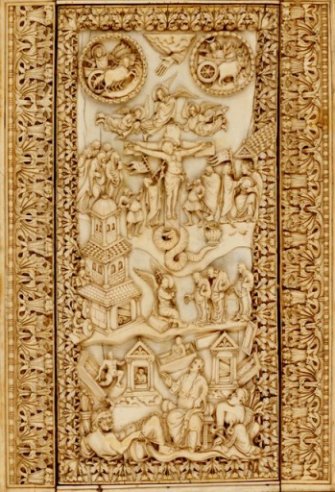|
So what are
they?
On the left above is the ivory cover from the
Pericopes of Henry II, an illuminated manuscript dating from c 1002. On
the right is the lid of the sarcophagus of Mayan King K'inich Janaab
Pakal I, who died in 683. The manuscript was produced at the Abbey of
Reichenau, in southern Germany. The sarcophagus was discovered in 1952
at the Mayan city of Palenque, in Southern Mexico.
The sarcophagus
lid.
K'inich Janaab Pakal I was the king of the Mayan city-state of Palenque, located
now in Southern Mexico. His long reign lasted from 615 – 683. His tomb
was discovered in 1952.
The complex iconography of the
lid of the sarcophagus has kept historians busy since it was discovered.
Pakal lies, infant-like, at the base of a stylised cruciform
tree.
Beneath him is the head of a serpent, sometimes interpreted as a skull.
Above the tree is a strange, supernatural bird. Around the top edge are
cosmological symbols of the sun, the moon, and stars; the celestial
realm.
The position of the king signifies resurrection
or rebirth, a return from the kingdom of the dead represented by the
gaping jaws of the snake. Pakal is shown as the maize god, the god of
the agricultural cycle; he has been resurrected as a divinity,
responsible for the cycle of death and renewal. The tree, bejewelled and
with writhing snakes, is bursting into life.
The pericopes cover.
A pericope is nothing to do with
submarines! It is a gospel text specifically selected for a particular
service or feast day. The cover of these pericopes is one of the finest
examples of Carolingian ivory carving.
The main element is the Crucifixion scene.
Christ is seen slumped on a roughly-hewn cross
with arms like cut tree branches. Whether He is represented here as
alive or dead is a matter for debate.
He is
surrounded by figures familiar in
crucifixion
scenes: John, Stephaton, Longinus, the weeping women. The allegorical
figure of Ecclesia collects the blood of Christ in a chalice. The two
figures to the far right have led to much debate. Synagogia?
Personification of Jerusalem? No one is quite sure, though the disc one
of them holds is highly suggestive of a paten, another Eucharistic
symbol.
Above the Crucifixion scene are angels carrying
the instruments of the Passion. Above them are the symbols of the moon
and sun.
Below the cross is a writhing serpent,
personifying sin and death, and also the serpent in the Garden of Eden
which caused the downfall of the first Adam. Christ, the second Adam,
has vanquished it.
Below the Crucifixion scene are the women at the
tomb, representing the Resurrection. This is reinforced with scene below
showing the resurrection of saints, as described in the Gospel of
Matthew:
‘And the graves were opened; and many bodies of
the saints which slept arose, And came out of the graves after his
resurrection, and went into the holy city, and appeared unto many.’
(Chapter
27 v 52-53)
At the base of the ivory are three very
strange figures. A semi-naked man with horns sprawls at the left,
pouring water from a vessel. This is Oceanus, a personification of the
ocean. To the left a bare-breasted woman suckles a snake. This is Terra,
the personification of the land. The central figure is another
bare-breasted woman. It is not clear what she represents, though
the best guess seems to be the temple. This theory is based on a
reference in a poem by the fifth-century poet Coelius Sedulius, familiar
to the Carolingians:
‘That marvellous temple,
filled with ancient religion, groaned like a sad foster-child and wept
for her own creator, as she beheld the roofs of the great temple fall.
When the temple veil rent she immediately showed her bare breast to all,
signifying that the secret things that were in were now to be revealed
to the Gentiles and all future people of faith.’
A comparison.
Clearly, any hint of Mayan culture was
unknown in Europe in the Middle Ages, and the two lifestyles and belief
systems were totally different. The Mayans had many gods. And yet it is
intriguing how many elements the two images have in common. Both of them
relate the wider universe – the sun, the stars, the sea and the earth –
to the narrative. Both images show the snake as personifying death and
evil, and the tree as the embodiment of new life and fertility: the tree
of life that ‘blossomed again in the resurrection so as to become the
beauty of all’. (Bonaventure,
The Tree of Life.) Above all, the central message
of both images is the same – the resurrection of a human into a god to
bring about rebirth and renewal.
Even here there are significant differences. As far as we know, Pakal
died a natural death, while Christ was sacrificed to bring that renewal
about. Of course, sacrifice was important in Mayan culture, and a bloody
business it was too. Let’s not forget, though, the importance of blood
in Christian theology; look again at Ecclesia in the pericope cover.
So what conclusions can be drawn? What the two images bring to
the fore are those nagging archetypes that just won’t go away. However
distant and unrelated cultures are, that collective unconscious keeps
throwing up those symbols. Individual minds can then interpret them and
use them in their own distinct way.
|

